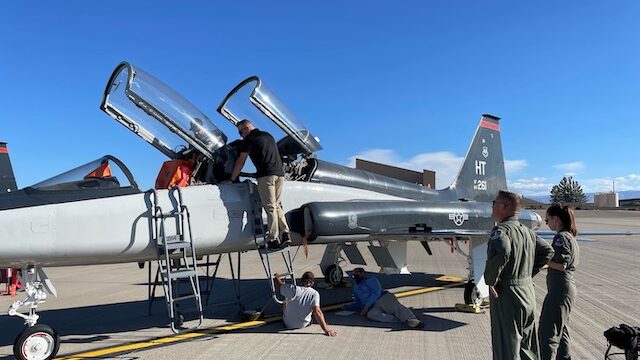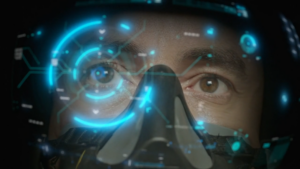
Red 6 conducts integration work of its augmented reality system onboard a US Air Force T-38. (Red 6)
DUBAI: California-based startup Red 6 is on track to integrate its augmented reality system with a T-38 trainer aircraft next year, potentially paving the way for the US Air Force to train fighter pilots in real airplanes how to dogfight using virtual enemies, the company’s chief executive told Breaking Defense.
Daniel Robinson, Red 6’s founder and CEO, said in a Nov. 14 interview that the company is hard at work transforming its Airborne Tactical Augmented Reality System, or ATARS, from a prototype to a hardened, ruggedized system capable of being used onboard military aircraft.
“The basic things we’ve got to figure out [are] where do we physically put it, and [in] what form factor?” Robinson said on the sidelines of the Dubai Airshow. “That’s a lot of engineering work and a lot of planning just to … make systems that are capable of being beaten up in the hands of fighter pilots, basically.”
Red 6’s concept revolves around the emerging technology of augmented reality, which superimposes virtual elements onto the real-world environment a user can physically see. (AR is the same technology that allowed people to chase virtual Pokemon around the real world in Pokemon GO, for better or worse.)

An illustration of virtual elements projected into the view of a pilot using augmented reality (AR). (Red 6 screengrab)
In August, Red 6 was awarded a $70 million contract to integrate its prototype ATARS system with the T-38 Talon, which is used to train fighter pilots before they transition to platforms like the F-16, F-15, F-22 or F-35.
If successful, the technology could provide the Air Force a more cost-effective way for pilots to dogfight realistic depictions of Russian and Chinese aircraft without having to rely on specially-trained “aggressor” pilots in real aircraft that play the role of adversary forces in live training events.
“We’re basically building ‘Ender’s Game,’” Robinson said, referencing the Orson Scott Card novel where a boy is trained in military tactics through massive, immersive wargames containing both live and virtual elements.
The ATARS system comprises a custom-built augmented reality headset fitted to a standard HGU-55 helmet, as well as pieces of hardware that plug into the aircraft itself and track a pilot’s head through space.
Red 6 has already built a prototype system for its Berkut 540 test aircraft, which the company has demonstrated multiple times through small business innovation research contracts with AFWERX, the Air Force’s innovation hub.
However, adapting that system for a T-38 poses a number of challenges in terms of ensuring the hardware is rugged enough to withstand daily operations, as well as fitting within the size, weight, power and cooling constraints posed by a training jet that first entered operations in the early 1960s, Robinson said.
“It’s all doable, [but] whenever you put things into military airplanes and there’s human beings involved, there’s all the safety stuff that goes with it,” he said. For example, the modifications to a T-38 pilot’s helmet could add weight and bulk. That means the new helmet must be ejection seat tested to ensure pilots aren’t incurring additional risk of head, neck or spinal cord injuries if they eject during an emergency.
A Denver-based team led by the Red 6’s chief technology officer, Todd Creek, is taking the lead on militarizing the company’s augmented reality system. Once that system is integrated with a T-38, the Air Force and Red 6 will begin ground and flight tests of a single aircraft. Eventually, the goal is to prove that multiple trainer aircraft can inhabit the same augmented reality world, fighting the same virtual adversaries without latency or technical glitches — all the while still keeping sensitive data secure.
“As you start to encrypt, it starts to impact latency,” Robinson said. “One of the challenges that we’ll have to be mindful of is how do we ensure that it’s encrypted and secure, while still maintaining the kind of latency we need to make it compelling.”
Earlier this month, Red 6 conducted its final capstone demonstration for AFWERX: a two-versus-one fight where its Berkut 540 test aircraft flew alongside an augmented reality version of the F-22 against a Chinese J-20. It was the the first time a virtual wingman and adversary had been simultaneously projected into an operator’s helmet.
“The F-22 on my wing, it’s flying and thinking for itself and doing [two-versus-one] tactics based on what I’m doing against the single airplane that we’re flying against,” Robinson said. Meanwhile, “the AI driving that [system] is fighting me — the real airplane — and the wingman. It’s crazy.”
The company has also seen increased interest from the US Navy, which attended the latest AFWERX demonstration. Robinson said the company expects a small business innovation research contract from the Navy in the near future to begin shaping a naval-aviation specific version of its augmented reality trainer.
“One of the cooler things we’re thinking about is… how difficult it is for the US Navy to train carrier landings. Imagine putting an augmented reality carrier out there in the sky, at 1,000 feet,” giving the service the ability to rehearse carrier landings with fewer risks to pilots and less wear and tear on fighter aircraft, he said. “The [ability to] practice, practice, practice has tremendous value for the Navy.






















